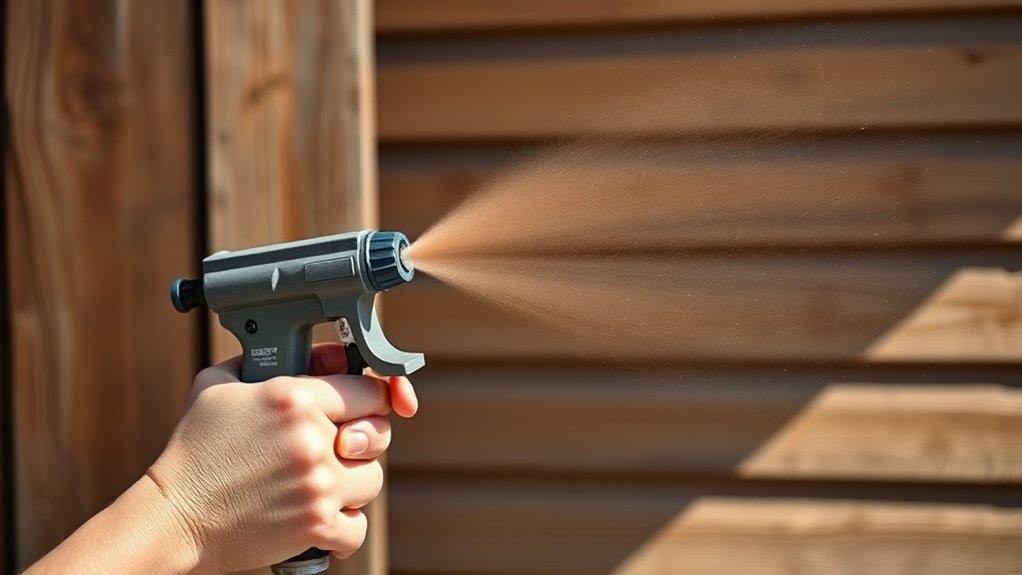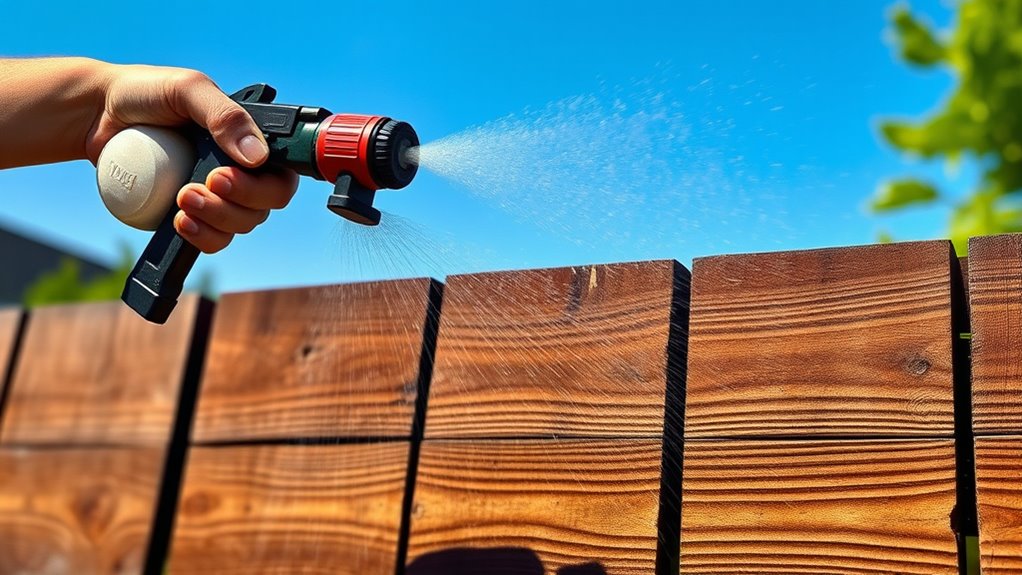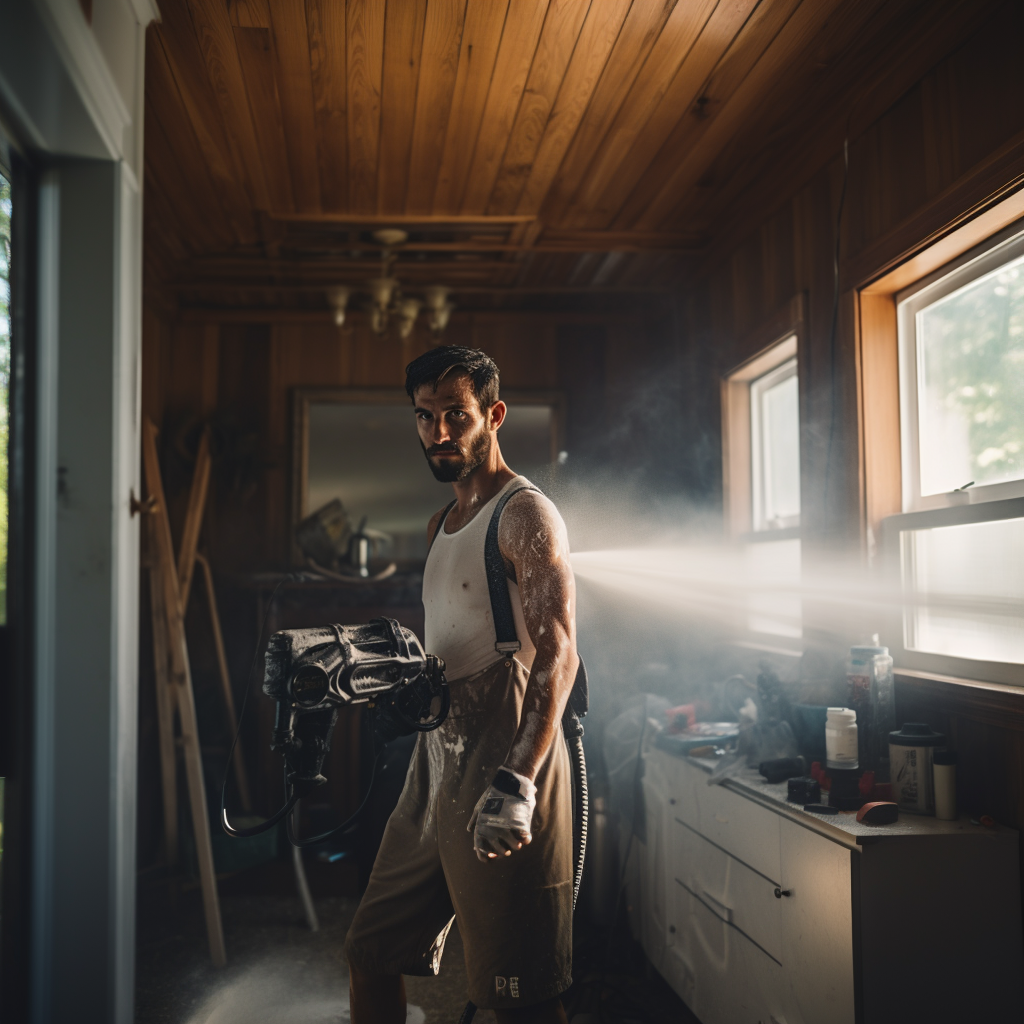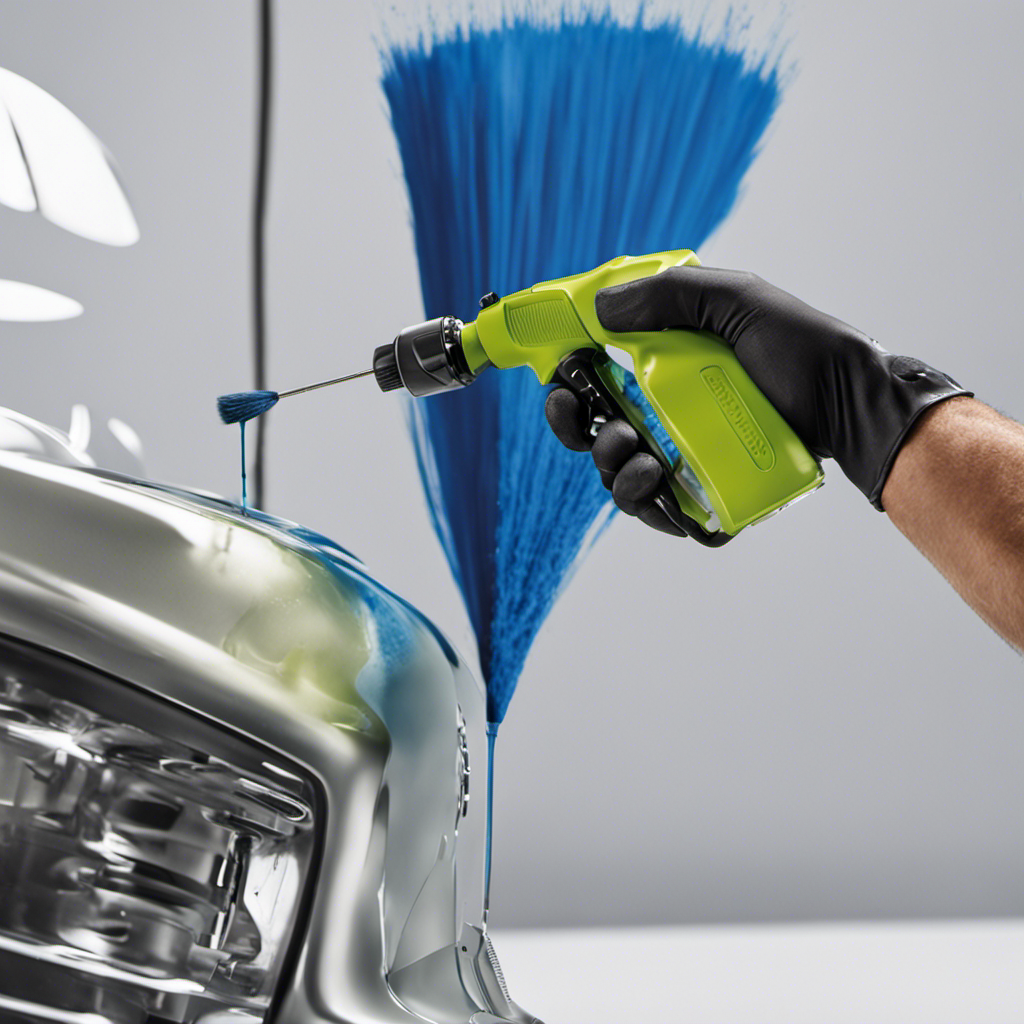To spray stain on fences and siding, start by choosing a suitable stain color that complements your home. Test a small area first to check the color and coverage. Use a sprayer designed for stain application and maintain a steady distance of 6 to 12 inches from the surface. Overlap your passes to ensure even coverage, and work in sections without stopping to avoid streaks. For a professional finish, follow up with a brush to smooth out drips and edges—more tips await if you keep going.
Key Takeaways
- Prepare the surface by cleaning and repairing any damage before staining.
- Choose a suitable stain color and test it on a small, hidden area for color accuracy.
- Use a stain-specific sprayer, maintaining a consistent distance of 6-12 inches from the surface.
- Work in sections with steady, overlapping passes to ensure even coverage and prevent streaks.
- Finish with a brush to blend edges, smooth overspray, and enhance stain penetration for durability.

Spraying stain on fences and siding offers a quick and efficient way to achieve a smooth, even finish. While spraying is faster than brushing, it still requires some preparation and technique to get professional-looking results. Before you begin, consider your stain color selection carefully. Choose a hue that complements your home’s exterior and enhances the natural beauty of the wood. Testing a small area first can help you verify the color and guarantee it matches your expectations. Once you’ve settled on the right shade, gather your equipment, including a sprayer suited for stain application and protective gear to avoid overspray and fumes.
Choosing the right stain color enhances your home’s exterior and wood’s natural beauty.
When it comes to applying stain, your brush techniques play a vital role in achieving a uniform coat. Although spraying covers large areas quickly, it’s wise to back up your work with some brushing, especially around edges and intricate details. Use a high-quality brush to smooth out any overspray or drips and to work the stain into the wood grain. This helps prevent uneven patches and ensures the stain penetrates deeply, enhancing durability. Always start by spraying the stain onto the surface from a consistent distance—usually around 6 to 12 inches—and maintain steady, overlapping passes. This overlap prevents streaks and ensures even coverage.
Keep in mind that proper stain color selection influences the final appearance and longevity. Lighter colors tend to highlight the wood’s natural texture, while darker shades provide a more dramatic, uniform look. Remember that some colors may appear different once they dry, so it’s wise to view samples in sunlight and shade. Also, consider the type of wood and its porosity, as these factors affect how the stain absorbs and shows through the color.
To optimize your spray technique, work in sections, maintaining a consistent speed and distance from the surface. Avoid stopping in one spot, as this can cause uneven buildup or drips. For best results, apply multiple thin coats rather than one thick layer, allowing each to dry according to the manufacturer’s instructions. After spraying, use your brush to lightly blend edges or touch up missed spots, ensuring a seamless finish.
Frequently Asked Questions
Can I Spray Stain in Rainy or Humid Weather?
You shouldn’t spray stain in rainy or humid weather because it affects the drying process and can lead to uneven coverage. Weather considerations are essential to guarantee the stain adheres properly and lasts longer. Plus, wet conditions make equipment maintenance harder, risking clogs or damage. Wait for clear, dry days to get the best results, and always check the weather forecast before starting your project.
How Often Should I Reapply Stain on My Fence or Siding?
You should reapply stain every 3 to 5 years, but it depends on your stain color options and application techniques. Keep an eye out for signs of wear, like fading or peeling, which signal it’s time to restore your fence or siding. Regular maintenance preserves your wood’s beauty and protection, so stay attentive to weathering and use proper techniques to ensure even coverage and lasting color.
What Safety Gear Is Necessary When Spraying Stain?
When spraying stain, you need to wear protective clothing like gloves, long sleeves, and eye protection to guard against splashes. Respiratory protection is essential; use a mask or respirator to avoid inhaling fumes and fine particles. This gear keeps you safe from harmful chemicals and irritants, ensuring a safer staining process. Always check the product label for specific safety recommendations before starting your project.
How Do I Prevent Overspray on Nearby Plants or Objects?
Think of your spray area as a delicate dance floor; you want to keep everything around it pristine. To prevent overspray on nearby plants or objects, use plant protection like plastic sheeting or drop cloths. Employ equipment masking on adjacent surfaces, and consider using a spray shield to control the spray pattern. These steps help protect your landscape while you achieve a smooth stain finish.
Can I Mix Different Stain Colors for a Custom Finish?
Yes, you can mix different stain colors for a custom finish. This allows for color blending and stain customization, giving you a unique look. To do this, start with small amounts, thoroughly mix the stains, and test on a scrap before applying to your surface. Keep in mind that mixing may alter the stain’s transparency and drying time, so adjust accordingly for the best results.
Conclusion
Now that you’ve mastered the art of spraying stain, your fences and siding will glow like a freshly painted masterpiece. Think of your brush as a magic wand, transforming dull wood into a vibrant canvas that tells your story. With each even spray, you’re sealing in beauty and protection, like a shield of armor. So grab your gear and release your inner artist—your home’s new look is just a spray away, waiting to shine brighter than ever.
Franz came aboard the Paint Sprayer Zone team with a background in both journalism and home renovation. His articulate writing style, combined with a passion for DIY projects, makes him an invaluable asset. Franz has a knack for breaking down technical jargon into easy-to-understand content, ensuring that even the most novice of readers can grasp the complexities of paint sprayers.










